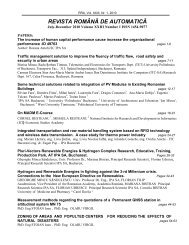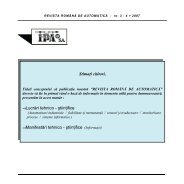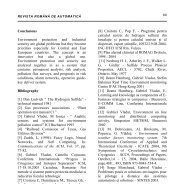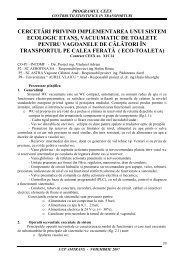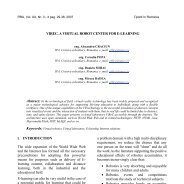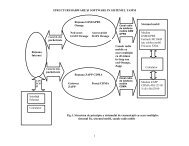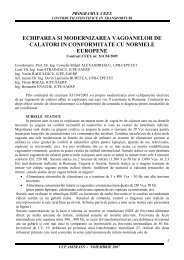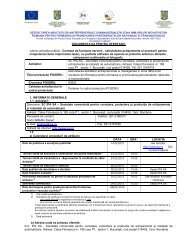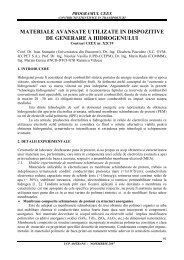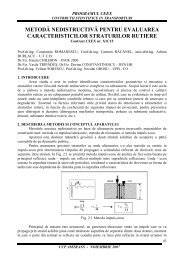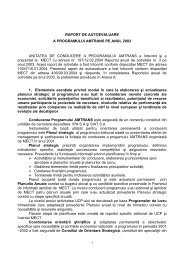REVISTA ROMÃNÄ DE AUTOMATICÄ - IPA SA
REVISTA ROMÃNÄ DE AUTOMATICÄ - IPA SA
REVISTA ROMÃNÄ DE AUTOMATICÄ - IPA SA
Create successful ePaper yourself
Turn your PDF publications into a flip-book with our unique Google optimized e-Paper software.
<strong>REVISTA</strong> ROMÂNĂ <strong>DE</strong> AUTOMATICĂ<br />
29<br />
(Arctic and R12), and, by 1990 numerous<br />
major equipments in producing menial<br />
refrigeration start to be commercialized<br />
(Zanussi, Electrolux, Indesit, Gorenje, etc),<br />
with thermodynamical performances and<br />
with various effects on the medium. If, in<br />
the beginning, the commercialization was<br />
accessible enough, allowing also<br />
equipments using refrigerants forbidden by<br />
the Montreal Protocol, after it’s ratification<br />
by Romania (1993) only refrigerating<br />
equipments with ecological working fluids<br />
have been imported (R134a, R600). In<br />
figure 1, we can observe a continuous<br />
volume rise of the cooling volume for the<br />
menial consumption. Simultaneously,<br />
because of the increased comfort and the<br />
need of a more reduced specific energy’s<br />
consumption, the population turns to more<br />
advanced equipments (with larger volumes, but<br />
more efficient), a contribution to this being<br />
brought by the energetic labeling of these<br />
equipments. More and more used are the<br />
refrigerators with more efficient equipments<br />
(compressors, heat exchangers), in search of<br />
placing them within the energetic classes A and<br />
A+. In figure 2 one can notice a drop of the<br />
specific energy’s consumption (W/l). The<br />
highest specific consumptions correspond to the<br />
more reduced volumes (65….1251), a<br />
characteristic of the less advanced Romanian<br />
equipments (ARCTIC- the old generation).<br />
Along with the rise of the cooled volume (the<br />
ones used lately being the equipments with<br />
higher volume), but also with the use of<br />
advanced equipments, one can observe a<br />
continuous diminish of the specific energy<br />
consumption.<br />
Cooled volume, [l]<br />
600<br />
500<br />
400<br />
300<br />
200<br />
100<br />
Specific consumptions,<br />
[kW/dayl]<br />
0,007<br />
0,006<br />
0,005<br />
0,004<br />
0,003<br />
0,002<br />
0,001<br />
0<br />
65 145 215 235 275 350 400<br />
0<br />
1975 1985 1990 2005<br />
Eyar<br />
Cooled volume, [l]<br />
Figure 1: The required cooled volume vs. year<br />
Figure 2: The variation of the energy specific<br />
consumption vs. cooled volume<br />
2.2. ENERGETIC CONSUMPTIONS<br />
FOR AIR CONDITIONING<br />
For home air conditioning, the corresponding<br />
rise of the electrical energy consumption is<br />
even more spectacular, being almost absent<br />
before 1990 and reaching today to a point<br />
with air conditioning installation in almost<br />
50% of homes. This phenomenon is due to<br />
the continuous rise of the air’s temperature in<br />
summer, on one hand, and to the comfort<br />
conditions inside the houses, which are<br />
higher by day, on the other hand. Considering<br />
the importance of electric energy<br />
consumption for building air conditioning out<br />
of the total of menial consumptions, we<br />
consider adequate the analysis of these<br />
individual consumptions, as well as the<br />
necessity of their reduction by adopting new<br />
design solutions and new exploitation<br />
techniques.<br />
Two systems for comfort ventilation inside<br />
buildings are being used: systems with direct<br />
evaporation (split, multisplit) and systems<br />
with indirect cooling with secondary<br />
refrigerant (chiller and fan coils).



